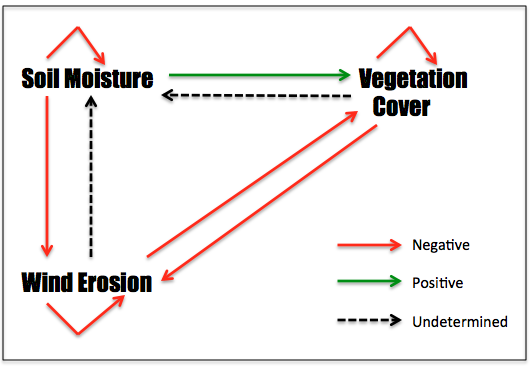A conversation with other scientists about severe, dust-bowl type wind erosion and erosion risks got me to thinking about the key interrelationships involved. The severe erosion and land degradation in the U.S. Great Plains in the 1930s was a combination of a particular confluence of environmental factors that set up aeolian erosion risk (climate, periodic low soil moisture, topography), a prolonged drought, and human factors (replacing natural grassland vegetation with crops that left fields bare part of the year). In other areas where the environmental risk factors are present, how stable or resilient is the landscape to severe wind erosion?

Archival photo from Kansas showing cropland degraded by wind erosion in the 1930s.
They key factors, as I seem them, are wind erosion, soil moisture, and vegetation cover. The key interactions are shown below. Negative links in this case mean that a change in one component results in a change in the other in the opposite direction. Thus, for instance, a decrease in soil moisture, other things being equal, leads to an increase in wind erosion, and increased soil moisture to reduced erosion. A positive link indicates that a change in one component leads to a change in the other in the same direction. Thus the only positive link in the model below shows that increases or decreases in soil moisture lead to corresponding increases or declines in vegetation cover. The dotted lines in the figure are undetermined. The vegetation to soil moisture link could be positive or negative. Denser vegetation could increase soil moisture in some cases due to shade effects and the role of soil organic matter in promoting moisture storage. On the other hand, plants use water, and denser vegetation could draw down soil moisture. The erosion to soil moisture link could be negative (due to loss of soil moisture storage capacity as topsoil is lost) or negligible (i.e., no arrow), if topsoil or soil thickness is not limiting with respect to water storage. The self-limiting negative links reflect the fact that soil moisture, wind, and vegetation all may be limited by factors other than each other, such as climate, nutrients, geomorphic processes, etc.

The dynamical stability (resilience) of the system can be determined using the Routh-Hurwitz criteria. This analysis shows that instability is possible when the vegetation cover to soil moisture link is positive, and the aeolian erosion to soil moisture link is negative. Dynamical instability indicates that the system is vulnerable to small changes and disturbances (i.e., changes in soil moisture, wind erosion, or vegetation). If the vegetation to moisture link is negative, and the effects of erosion on soil moisture are unimportant, the system is stable and therefore resilient to non-catastrophic changes.
So what does this all mean? First, it may provide a framework for assessing vulnerability to land degradation by wind erosion. Second, it highlights key research needs to make such assessments—specifically, how soil moisture responds to soil loss from aeolian erosion and to changes in vegetation cover, which no doubt vary in specific environments.
A final note: instability is not always a bad thing. If the system is already degraded or threatened, dynamical instability suggests that measures such as erosion control or vegetation establishment can “flip” the system to a more preferable state.
